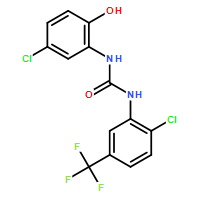| 中文名称: | NS1738 | ||||
|---|---|---|---|---|---|
| 英文名称: | NS1738 | ||||
| 别名: | NS1738 NSC213859 | ||||
| CAS No: | 501684-93-1 | 分子式: | C14H9Cl2F3N2O2 | 分子量: | 365.13 |
| CAS No: | 501684-93-1 | ||||
| 分子式: | C14H9Cl2F3N2O2 | ||||
| 分子量: | 365.13 | ||||
基本信息
|
产品编号: |
N11039 |
||||
|
产品名称: |
NS1738 |
||||
|
CAS: |
501684-93-1 |
储存条件 |
粉末 |
-20℃ |
四年 |
|
|
|
||||
|
分子式: |
溶于液体 |
-80℃ |
6个月 |
||
|
分子量: |
365.13 |
-20℃ |
1个月 |
||
|
化学名: |
Urea,N-(5-chloro-2-hydroxyphenyl)-N'-(2-chloro-5-(trifluoromethyl)phenyl)- |
||||
|
Solubility (25°C): |
|||||
|
体外:
|
DMSO |
|
|||
|
Ethanol |
|
||||
|
Water |
|
||||
|
体内(现配现用): |
|
||||
|
<1mg/ml表示微溶或不溶。 |
|||||
|
普西唐提供的所有化合物浓度为内部测试所得,实际溶液度可能与公布值有所偏差,属于正常的批间细微差异现象。 |
|||||
|
请根据产品在不同溶剂中的溶解度选择合适的溶剂配制储备液;⼀旦配成溶液,请分装保存,避免反复冻融造成的产品失效。 |
|||||
制备储备液
|
浓度
溶液体积 质量 |
1mg |
5mg |
10mg |
|
1mM |
2.7388mL |
13.6938mL |
27.3875mL |
|
5mM |
0.5478mL |
2.7388mL |
5.4775mL |
|
10mM |
0.2739mL |
1.3694mL |
2.7388mL |
生物活性
|
产品描述 |
一种新型的α7nAChR正向变构调节剂。在卵母细胞实验中,正调节α7nAChR,EC50为3.4μM。 |
|
靶点 |
EC50:3.4μM (α7 nAChR,in oocyte experiments) |
|
体外研究 |
NS 1738 acts by increasing the peak amplitude of acetylcholine (ACh)-evoked currents at all concentrations;thus,it increased the maximal efficacy of ACh.Plotting peak current amplitude against the logarithm of the NS 1738 concentration used for preincubation reveals a sigmoidal concentration-response relationship that is well fit by the Hill equation (EC50=3.4μM).Under similar experimental conditions,NS 1738 shows comparable efficacy and potency at the rat α7 nAChR (EC50=3.9μM). |
|
体内研究 |
To estimate the ability of NS 1738 to permeate the blood-brain barrier,rats are administered 10mg/kg NS 1738 intraperitoneally.Peak brain concentrations are measured approximately 30 min after injection,and they amount to ~80ng/mL (~200nM) at this dose.The ratio between the amount of compound entering the brain and that in plasma is AUCbrain/AUCplasma=0.50.The half-life in plasma is estimated to 42 min.Incubation of NS1738 with isolated liver microsomes in vitro indicates that approximately 60 and 75% of NS 1738 is metabolized via the cytochrome P450 system in mouse and rat,respectively,within 1h.Adult rats administered NS 1738 at 10 and 30mg/kg i.p.immediately following the initial exposure to a juvenile rat (T1) display significant decreases in the investigative duration of a subsequent exposure to the same juvenile (T2) 2 h later (T2/T1 ratio of 0.69±0.13 and 0.61±0.07,respectively). |
推荐实验方法(仅供参考)
|
动物实验: |
|
|
Rats Sprague-Dawley rats are used.Adult (2-4 months;400-450g) and juvenile (50-60g) animals are allowed to acclimate to the test room for 90 to 120 min before starting.After acclimation,adult rats are placed alone in their respective test cages.After a brief habituation period (30 min),they are allowed to interact for 5 min with a juvenile rat (trial;T1).During the interactive trial,the adult exhibits investigative behaviors that include close following,grooming,and/or sniffing of the juvenile for as much as 40 to 50% of the trial duration.The time of the investigative interaction is recorded in seconds.The juvenile rat is then removed,and the adult rats are immediately administered varying doses of NS 1738 (10 and 30mg/kg NS-1738 i.p.) [prepared in 5% ethanol/95% hydroxypropyl-B-cyclodextrin (34% solution);2.0mL/kg i.p.] or Nicotine (0.1mg/kg i.p.),and then they are returned to their home cage.A second 5-min interactive trial (T2) is conducted 120 min later in the same test cage,and investigative behavior of the adult rat is again monitored and the time is recorded. Recognition ratios of time spent investing the familiar juvenile in T2 divided by time spent investigating the juvenile in T1 are calculated. |
|
本计算器可帮助您计算出特定溶液中溶质的质量、溶液浓度和体积之间的关系,公式为:
质量 (g) = 浓度 (mol/L) x 体积 (L) x 分子量 (g/mol)
摩尔浓度计算公式
用本工具协助配置特定浓度的溶液,使用的计算公式为:
开始浓度 x 开始体积 = 最终浓度 x 最终体积
稀释公式
稀释公式一般简略地表示为:C1V1 = C2V2 ( 输入 输出 )








